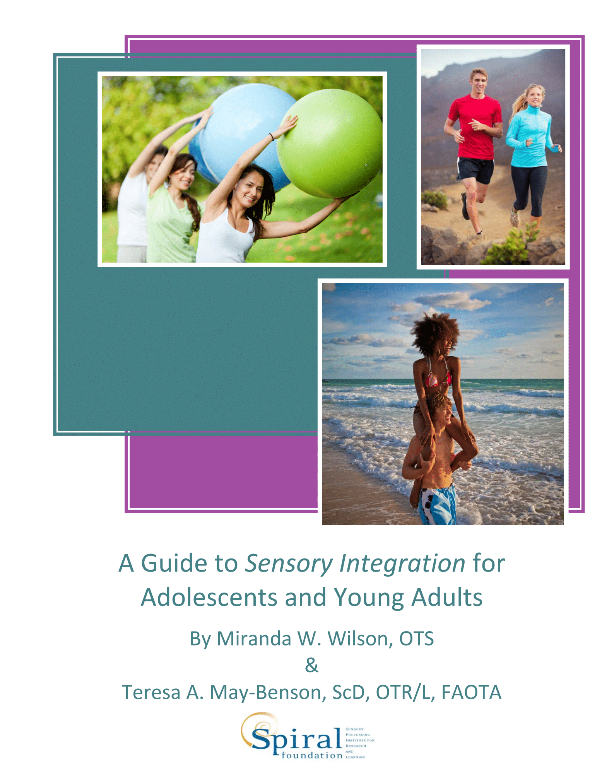SPD Education Toolkit
For Adults and Adolescents
This toolkit, is a collection of free resources related to the understanding and identification of, and intervention for, Sensory Processing Disorder (SPD) and related diagnoses, designed to help adults and adolescents with SPD and other non-professionals, better understand sensory processing difficulties and advocate for themselves and their needs. All resources on this page are provided under a Creative Commons license and may be copied and distributed with attribution for noncommercial use. Supported by grants from the John W. Alden Trust and the Maxwell Hurston Charitable Foundation,
![]() This work is licensed under an Attribution-NonCommercial-NoDerivs 3.0 Unported License.
This work is licensed under an Attribution-NonCommercial-NoDerivs 3.0 Unported License.
Introduction to Sensory Integration
“A Guide to Sensory Integration for Adolescents and Young Adults” is a free downloadable handbook for teens and young adults who have recently been diagnosed with Sensory Processing Disorder or who suspect they may have sensory processing problems.
It provides a brief introduction to the history of sensory integration, descriptions of common signs and symptoms, an overview of different types of interventions, and more.
Download “A Guide to Sensory Integration for Adolescents and Young Adults”
![]() Download English (PDF)
Download English (PDF)
![]() Download Portuguese (PDF)
Download Portuguese (PDF)
How Do I Know?
Sensory Processing Disorder, and other sensory-related dysfunctions, can present in all sorts of different ways. These ‘How Do I Know?’ checklists are tailored to adults and adolescents and offer a quick and easy way to determine if sensory integration-based therapies may be helpful for you or someone you know.
They are not exhaustive and cannot, and should never, replace a proper evaluation, but they can be a good place to start if you believe you may have sensory processing difficulties.
![]() Download ‘How Do I Know Packet – Adults’ (ZIP)
Download ‘How Do I Know Packet – Adults’ (ZIP)
Includes checklists in the following languages: English, German, Portuguese, Russian, and Turkish.
Adult Sensory Toolkit
Simple sensory regulation activities that can be done at home, school, or work, broken down by sensory system. The Additional Information brochure provides more details about how to do these activities as well as additional resources.
![]() Adult Sensory Toolkit – Additional Information (PDF)
Adult Sensory Toolkit – Additional Information (PDF)
Sensory Friendly Clothing List
Finding clothing that is acceptable for an individual with tactile defensiveness can be a challenge. Each nervous system is different so what works well for one person may not work for another. This free resource provides a list of clothing brands that may be more acceptable to a sensitive nervous system to get the process started.
![]() Adult Sensory Friendly Clothing List (PDF)
Adult Sensory Friendly Clothing List (PDF)
Developing Your Own Sensory Diet
A Sensory Diet is a controlled program of interaction with sensory input throughout the day, that help us to be alert and adaptable, so we are able to function to the best of our abilities in our environment.
Sensory diets may be developed independently or with the help of an occupational therapist, and may be used in conjunction with other programs, as a transition to or from other programs, or as a primary maintenance and accommodation program.
We all have sensory activities we perform to help keep us regulated and focused. You may be able to think of a few already: drinking your morning coffee or going for your evening run. Sensory diets are just another way of structuring many of the things you already do.
Download the ‘Developing Your Own Sensory Diet’ kit below for worksheets and tips on how to identify your own sensory needs and build your own sensory diet!
![]() Download ‘Developing Your Own Sensory Diet’ (ZIP)
Download ‘Developing Your Own Sensory Diet’ (ZIP)
Additional Books
Too Loud, Too Bright, Too Fast, Too Tight: What to Do If You Are Sensory Defensive in an Overstimulating World (2003)
One of the few books available on Sensory Processing Disorder and adults. A classic book by the ‘mother’ of sensory integration, updated and parent-friendly. It remains a valuable work on the subject, both practically and historically.
The Sensory Team Handbook: A Hands-On Tool to Help Young People Make Sense of Their Senses and Take Charge of Their Sensory Processing (2009)
Geared towards adolescents and teenagers. The Sensory Team Handbook takes a humorous approach in providing tips and strategies to help adolescents identify and manage their own sensory needs.
Articles & Papers
Though geared towards professionals, these two articles, originally published in OT Practice, provide and accessible introduction to the current understanding of sensory processing and Sensory Processing Disorder in adults. Both papers by Teresa May-Benson, ScD, OTR/L, FAOTA.
![]() Download “Understanding the Occupational Therapy Needs of Adults with Sensory Processing Disorder” (PDF)
Download “Understanding the Occupational Therapy Needs of Adults with Sensory Processing Disorder” (PDF)
![]() Download “Occupational Therapy for Adults with Sensory Processing Disorder” (PDF)
Download “Occupational Therapy for Adults with Sensory Processing Disorder” (PDF)
![]()
All works on this page are licensed under an Attribution-NonCommercial-NoDerivs 3.0 Unported License.


